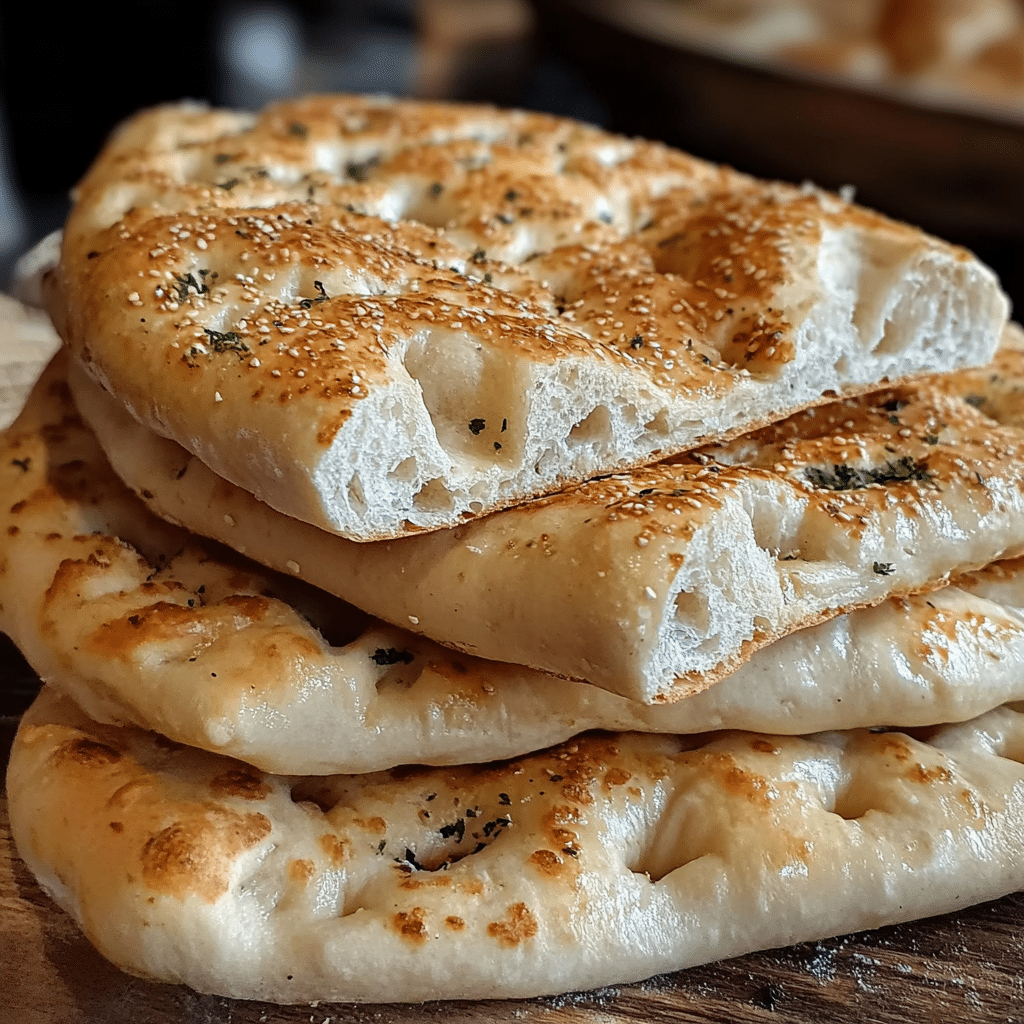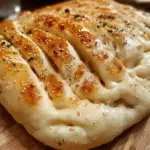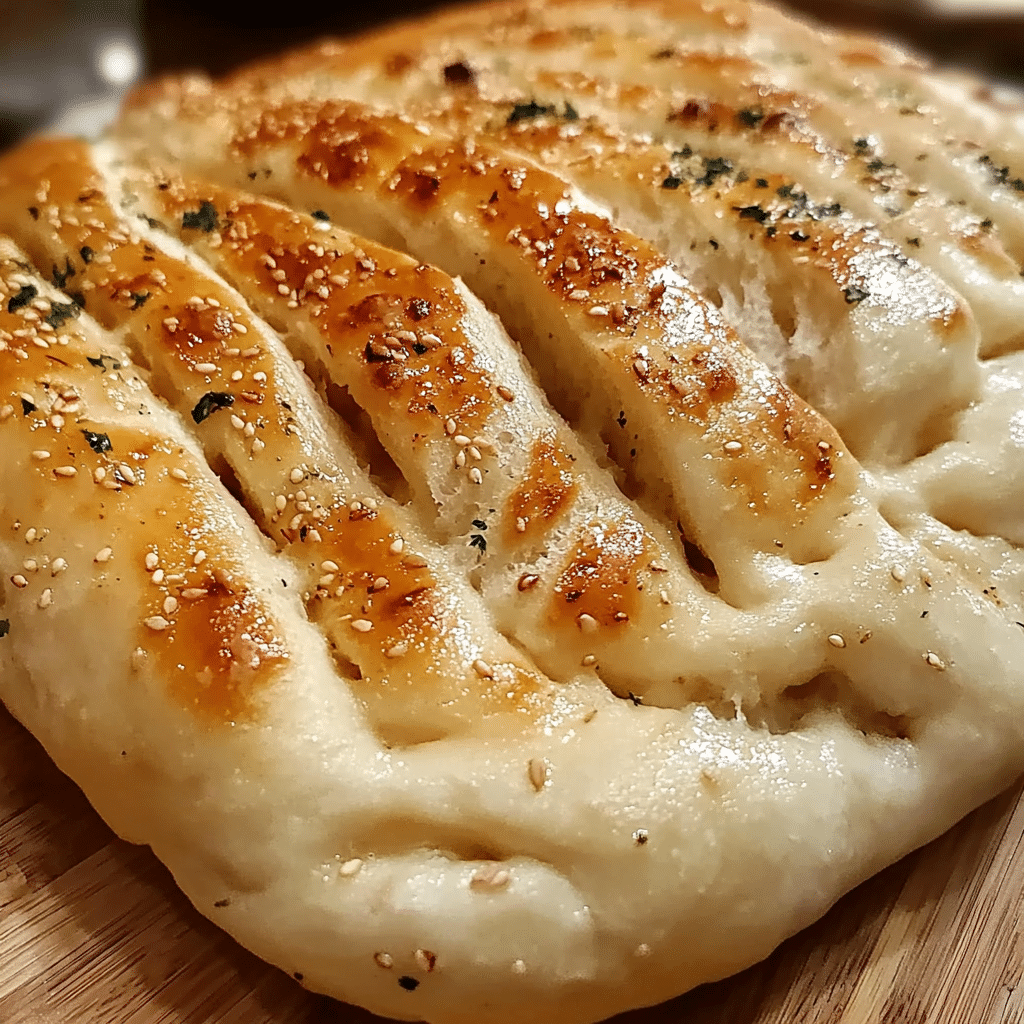Introduction
Turkish Bread (known as Pide or Ekmek in Turkey) is a soft, fluffy, and slightly chewy bread that pairs perfectly with a variety of dishes. Its light texture and slightly crispy exterior make it ideal for dipping in olive oil, hummus, or enjoying with soups, stews, or grilled meats.
I first made this bread when I wanted to try something new for dinner, and it quickly became a staple in our household. The aroma of freshly baked bread is so comforting, and the texture is perfect for scooping up dips or sopping up sauces. What I love most about Turkish bread is how versatile it is—it’s a wonderful addition to any meal, whether it’s a simple dinner or a more elaborate feast. The dough is made from just a few basic ingredients, yet it yields a bread that’s soft, flavorful, and truly authentic.
Whether you’re making it for a cozy meal at home or serving it at a gathering, Turkish bread is always a crowd-pleaser. It’s simple to make, yet offers a rich, homemade taste that brings a little piece of Turkey into your kitchen.
Perfect for:
- Everyday meals
- Dipping in olive oil and hummus
- Accompanying soups and stews
- Grilled meats or kebabs
- Turkish-style breakfast spreads
Why You’ll Love This Turkish Bread
Here’s why Turkish Bread will become your new favorite:
- Soft and Fluffy: The dough rises beautifully to create a bread with a tender crumb and airy texture, perfect for any meal.
- Crispy Crust: The exterior of the bread turns golden and slightly crispy, creating the ideal contrast to the soft interior.
- Versatile: This bread is perfect for any occasion, whether it’s a casual dinner or a festive celebration.
- Simple to Make: The dough requires minimal ingredients, yet it results in an incredibly flavorful, homemade bread.
- Authentic Taste: By following this recipe, you can recreate the authentic taste of Turkish bread right in your own kitchen.
Preparation and Cooking Time
- Total Time: 2 hours 30 minutes
- Preparation Time: 30 minutes
- Rising Time: 1 hour 30 minutes
- Cooking Time: 25-30 minutes
- Servings: 1 large loaf or 2 smaller loaves
- Calories per serving: Approximately 120-150 calories
- Key Nutrients: Protein: 4g, Carbs: 22g, Fat: 1g
Ingredients
Gather these ingredients to make your Turkish Bread:
- 3 cups all-purpose flour
- 1 packet active dry yeast (or 2 ¼ teaspoons)
- 1 tablespoon sugar
- 1 teaspoon salt
- 1 tablespoon olive oil
- 1 cup warm water (around 110°F/45°C)
- 1 tablespoon yogurt (optional for extra softness)
- 1 tablespoon sesame seeds (optional, for topping)
Ingredient Highlights
- Flour: The key to a soft and airy bread, all-purpose flour is perfect for creating the light, chewy texture of Turkish bread.
- Yeast: Active dry yeast helps the dough rise, giving the bread its fluffy texture.
- Olive Oil: Olive oil adds richness to the dough and helps achieve a slightly crispy crust.
- Yogurt: A tablespoon of yogurt adds softness and moisture to the bread, making it extra tender.
- Sesame Seeds: Optional, but they add a nutty crunch to the bread’s crust, making it more flavorful.
Step-by-Step Instructions
Here’s how to make Turkish Bread:
Prepare the Dough:
- Activate the Yeast: In a small bowl, combine the warm water, sugar, and yeast. Stir gently and let it sit for about 5-10 minutes until it becomes frothy.
- Mix the Dry Ingredients: In a large bowl, whisk together the flour and salt.
- Make the Dough: Add the activated yeast mixture and olive oil to the flour mixture. Stir to combine and form a dough.
- Knead the Dough: Transfer the dough to a floured surface and knead for about 8-10 minutes, or until the dough becomes smooth and elastic.
- Let the Dough Rise: Place the dough in a lightly greased bowl, cover it with a clean towel, and let it rise in a warm place for 1-1.5 hours or until it doubles in size.
- Punch Down the Dough: Once the dough has risen, punch it down gently to release any air bubbles, then divide the dough into two equal portions if you want to make smaller loaves.
Shape and Bake the Bread:
- Shape the Dough: Shape each portion into a round or oval loaf. You can also stretch it out into a flatter shape, depending on your preference.
- Prepare for Baking: Place the shaped dough onto a baking sheet lined with parchment paper. Cover the dough again and let it rise for an additional 30 minutes.
- Preheat the Oven: Preheat your oven to 425°F (220°C). If you want a crispier crust, you can place a small oven-safe bowl of water in the oven to create steam while baking.
- Add Toppings: Before baking, brush the dough with a bit of olive oil and sprinkle with sesame seeds if desired.
- Bake the Bread: Bake for 25-30 minutes, or until the bread is golden brown and sounds hollow when tapped on the bottom.
- Cool: Let the bread cool slightly before slicing and serving.

How to Serve Turkish Bread
Turkish Bread is perfect for serving in a variety of ways:
- With Dips: Serve with olive oil, balsamic vinegar, or hummus for a light appetizer.
- As a Side: Pair with grilled meats, salads, or stews for a complete meal.
- For Breakfast: Serve alongside eggs, cheese, and olives for a traditional Turkish breakfast.
- As a Sandwich: Slice the bread and use it to make a delicious sandwich with fresh veggies, cheese, and your favorite spread.
Additional Tips for Turkish Bread
Here are some tips to ensure your Turkish Bread is perfect every time:
- Check the Temperature of the Water: Make sure the water is warm (but not too hot) to activate the yeast properly. It should feel like warm bathwater, around 110°F/45°C.
- Knead Well: Kneading the dough properly ensures a soft and fluffy texture. Take your time and knead until the dough is smooth and elastic.
- Use Fresh Yeast: If possible, use fresh yeast for the best results. If using dry yeast, be sure it is within its expiration date.
- Steam for a Crispy Crust: If you prefer a crispier crust, add a small pan of water to the oven to create steam during baking.
- Store Properly: Turkish bread is best eaten fresh, but it can be stored in an airtight container for up to 2-3 days or frozen for longer storage.
Recipe Variations for Turkish Bread
Here are 10 variations you can try for Turkish Bread:
- Olive and Herb Turkish Bread: Add chopped olives and herbs like rosemary or thyme to the dough for an extra burst of flavor.
- Garlic Turkish Bread: Brush the bread with a garlic and olive oil mixture before baking for a savory twist.
- Cheese-Stuffed Turkish Bread: Roll cheese (such as feta or mozzarella) into the dough for a cheesy surprise inside.
- Turkish Bread with Za’atar: Sprinkle za’atar seasoning on top of the dough for a Middle Eastern twist.
- Honey and Sesame Turkish Bread: Brush the dough with honey and sprinkle sesame seeds on top for a sweet and nutty flavor.
- Turkish Flatbread (Pide): Roll the dough into thin, flat rounds and bake for a traditional Turkish flatbread.
- Whole Wheat Turkish Bread: Substitute half of the all-purpose flour with whole wheat flour for a more wholesome version.
- Sun-Dried Tomato Turkish Bread: Add finely chopped sun-dried tomatoes to the dough for a burst of umami flavor.
- Cinnamon and Sugar Turkish Bread: Sweeten the dough with cinnamon and sugar for a dessert version of Turkish bread.
- Gluten-Free Turkish Bread: Use a gluten-free flour blend to make a gluten-free version of this bread.
Freezing and Storage for Turkish Bread
- Freezing: Turkish bread freezes well. Wrap the cooled bread tightly in plastic wrap and store it in a zip-top bag for up to 3 months. Thaw at room temperature before serving.
- Storage: Store leftover bread in an airtight container at room temperature for up to 3 days.
Special Equipment for Turkish Bread
Here are some special equipment items to make preparing your Turkish Bread easier:
- Mixing Bowls: Use large bowls to mix and knead the dough.
- Dough Scraper: A dough scraper can help when handling sticky dough or dividing it into portions.
- Baking Sheets: Use a baking sheet lined with parchment paper for easy bread removal.
- Kitchen Towel: Cover the dough during its rising time to keep it warm and allow it to rise properly.
- Oven Thermometer: If you’re unsure of your oven’s temperature, an oven thermometer can help ensure the bread bakes at the correct temperature.
Frequently Asked Questions for Turkish Bread
- Can I use instant yeast instead of active dry yeast?
Yes, you can use instant yeast. Simply add it directly to the flour without needing to activate it in warm water. - Can I make this bread without olive oil?
Yes, you can substitute olive oil with melted butter or even vegetable oil if you prefer. - Can I make Turkish bread without yogurt?
Yes, yogurt is optional, but it helps add moisture and softness. You can omit it if you prefer. - How can I achieve a crispier crust?
Bake the bread at a high temperature (425°F/220°C), and create steam in the oven by placing a pan of water in the oven during baking.

Turkish Bread
- Total Time: 2 hours 30 minutes
- Yield: 1 large loaf or 2 smaller loaves 1x
Description
Turkish Bread (known as Pide or Ekmek in Turkey) is a soft, fluffy, and slightly chewy bread that pairs perfectly with a variety of dishes. Its light texture and slightly crispy exterior make it ideal for dipping in olive oil, hummus, or enjoying with soups, stews, or grilled meats. This bread is commonly made in Turkish households, and its versatility makes it a favorite for both everyday meals and special occasions. With a simple dough made from flour, water, yeast, and salt, this bread brings the authentic taste of Turkish cuisine to your kitchen.
Ingredients
- 3 cups all-purpose flour
- 1 packet active dry yeast (or 2 ¼ teaspoons)
- 1 tablespoon sugar
- 1 teaspoon salt
- 1 tablespoon olive oil
- 1 cup warm water (around 110°F/45°C)
- 1 tablespoon yogurt (optional for extra softness)
- 1 tablespoon sesame seeds (optional, for topping)
Ingredient Highlights
- Flour: The key to a soft and airy bread, all-purpose flour is perfect for creating the light, chewy texture of Turkish bread.
- Yeast: Active dry yeast helps the dough rise, giving the bread its fluffy texture.
- Olive Oil: Olive oil adds richness to the dough and helps achieve a slightly crispy crust.
- Yogurt: A tablespoon of yogurt adds softness and moisture to the bread, making it extra tender.
- Sesame Seeds: Optional, but they add a nutty crunch to the bread’s crust, making it more flavorful.
Instructions
Prepare the Dough:
- Activate the Yeast: In a small bowl, combine the warm water, sugar, and yeast. Stir gently and let it sit for about 5-10 minutes until it becomes frothy.
- Mix the Dry Ingredients: In a large bowl, whisk together the flour and salt.
- Make the Dough: Add the activated yeast mixture and olive oil to the flour mixture. Stir to combine and form a dough.
- Knead the Dough: Transfer the dough to a floured surface and knead for about 8-10 minutes, or until the dough becomes smooth and elastic.
- Let the Dough Rise: Place the dough in a lightly greased bowl, cover it with a clean towel, and let it rise in a warm place for 1-1.5 hours or until it doubles in size.
- Punch Down the Dough: Once the dough has risen, punch it down gently to release any air bubbles, then divide the dough into two equal portions if you want to make smaller loaves.
Shape and Bake the Bread:
- Shape the Dough: Shape each portion into a round or oval loaf. You can also stretch it out into a flatter shape, depending on your preference.
- Prepare for Baking: Place the shaped dough onto a baking sheet lined with parchment paper. Cover the dough again and let it rise for an additional 30 minutes.
- Preheat the Oven: Preheat your oven to 425°F (220°C). If you want a crispier crust, you can place a small oven-safe bowl of water in the oven to create steam while baking.
- Add Toppings: Before baking, brush the dough with a bit of olive oil and sprinkle with sesame seeds if desired.
- Bake the Bread: Bake for 25-30 minutes, or until the bread is golden brown and sounds hollow when tapped on the bottom.
- Cool: Let the bread cool slightly before slicing and serving.
- Prep Time: 30 minutes
- Rising Time: 1 hour 30 minutes
- Cook Time: 25-30 minutes
Nutrition
- Calories: 120-150 kcal
- Fat: 1g
- Carbohydrates: 22g
- Protein: 4g
Conclusion
Turkish Bread is a simple yet flavorful addition to any meal. Whether enjoyed with a variety of dips, alongside a hearty stew, or as a base for sandwiches, this bread offers a wonderful balance of textures and flavors. Its soft, fluffy interior and golden, slightly crispy crust make it irresistible. With easy-to-find ingredients and minimal preparation, you can enjoy the authentic taste of Turkish bread in your own home.
This recipe is as easy to make as it is delicious, making it perfect for everything from casual weeknight dinners to gathering with friends. Whether you’re serving it as a side or using it as the star of your meal, Turkish bread will elevate any dish it’s paired with.
I’d love to see how your Turkish Bread turns out! Snap a photo, share it on social media, and don’t forget to tag me—I can’t wait to see your delicious creations. Happy baking!











